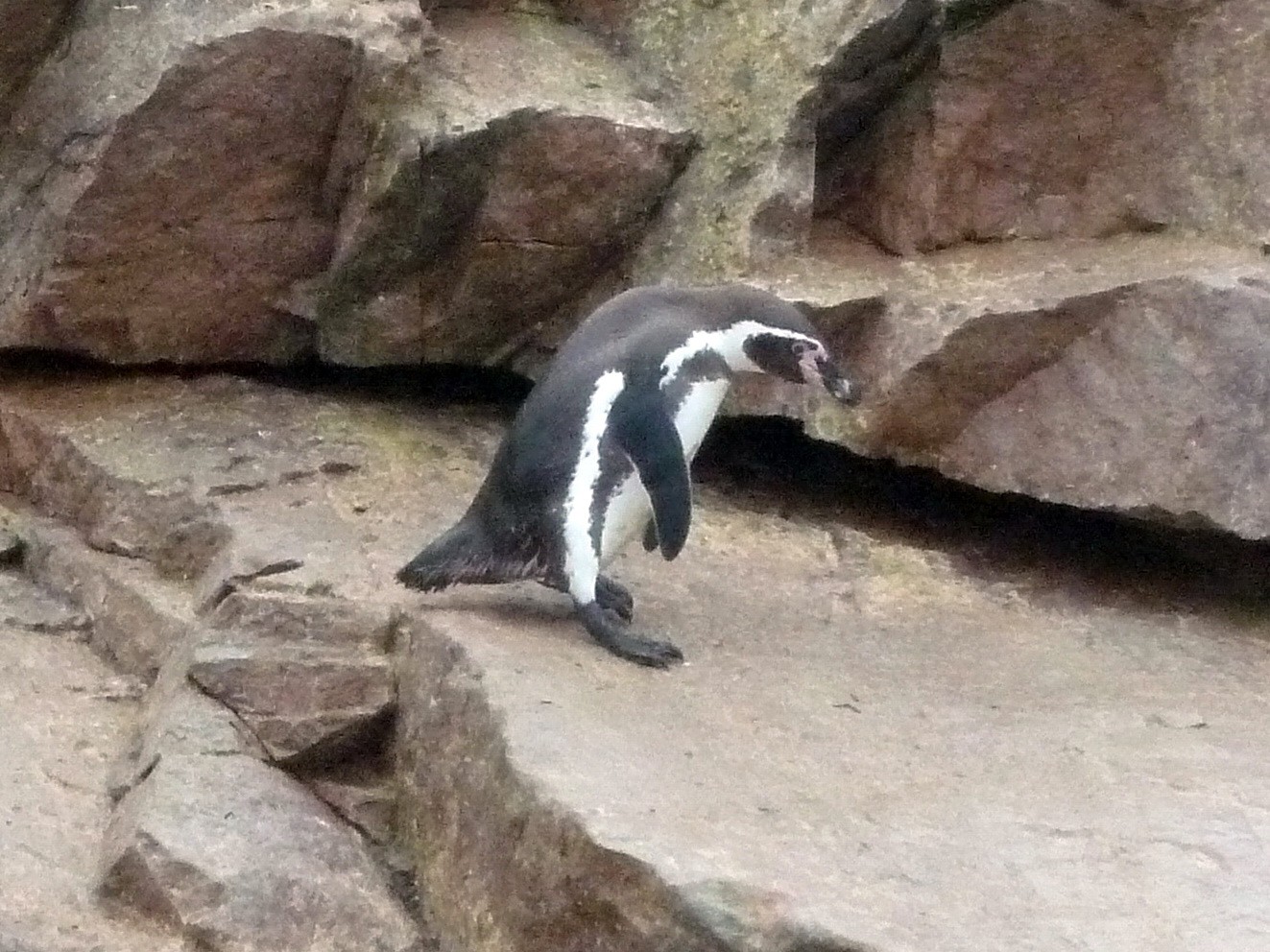Humboldt Penguin
A species of Banded penguins Scientific name : Spheniscus humboldti Genus : Banded penguins
Humboldt Penguin, A species of Banded penguins
Botanical name: Spheniscus humboldti
Genus: Banded penguins
Description
The Humboldt penguin (Spheniscus humboldti) is a South American penguin living mainly in the Pingüino de Humboldt National Reserve in the North of Chile, although its habitat comprises most of coastal Peru. Its nearest relatives are the African penguin, the Magellanic penguin and the Galápagos penguin. The Humboldt penguin and the cold water current it swims in both are named after the explorer Alexander von Humboldt. The species is listed as vulnerable by the IUCN with no population recovery plan in place. The current population is composed of 32,000 mature individuals and is going down. It is a migrant species. Humboldt penguins are medium-sized penguins, growing to 56–70 cm (22–28 in) long and a weight of 3.6-5.9 kg (8-13 lbs). They have a black head with a white border that runs from behind the eye, around the black ear-coverts and chin, and joins at the throat. They have blackish-grey upperparts and whitish underparts, with a black breast-band that extends down the flanks to the thigh. They have a fleshy-pink base to the bill. Juveniles have dark heads and no breast-band. They have spines on their tongue which they use to hold their prey. Humboldt penguins nest on islands and rocky coasts, burrowing holes in guano and sometimes using scrapes or caves. In South America the Humboldt penguin is found only along the Pacific coast, and the range of the Humboldt penguin overlaps that of the Magellanic penguin on the central Chilean coast. It is vagrant in Ecuador and Colombia. The Humboldt penguin has been known to live in mixed species colonies with the Magellanic penguin in at least two different locations at the south of Chile. The Humboldt penguin has become a focus of ecotourism over the last decades. 
Size
70 cm
Life Expectancy
20 years
Nest Placement
Burrow
Feeding Habits
Humboldt Penguin primarily feed on pelagic schooling fish, squid, and crustaceans. Humboldt Penguin hunt by diving, utilizing their excellent underwater vision and agility to capture prey. Unique adaptations include a tapered bill and spiny tongue to grasp slippery food.
Habitat
The humboldt Penguin predominantly inhabits marine environments characterized by islands and craggy stretches of mainland coastline. These regions often contain sea cliffs and caves vital for the species' nesting practices. Humboldt Penguin demonstrates a preference for areas enriched with guano deposits, where it digs out nesting burrows. This bird primarily forages inshore, indicating a reliance on coastal waters for its feeding activities.
Dite type
Piscivorous
People often ask
Migration Overview
Humboldt penguins are sedentary during the breeding season, staying in proximity to their nests and show fidelity to breeding site. They can cover large distances, particularly in response to food shortages or changes in environmental conditions. They are a true migrant between Peru and Chile. 
General Info
Feeding Habits
Bird food type
Behavior
The Humboldt penguin is a visual hunter. Humboldt penguins leave their islands for foraging after sunrise and different populations have different preferred foraging distances from the colony. Their foraging rhythm depends on the light intensity. They spend more time foraging during overnight trips. Fish are mostly seized from below through short, shallow dives. The foraging range of Humboldt penguins is between 2 and 92 km from Pan de Azúcar, with 90% of the foraging being from a range of 35 km around the island and 50% from a range of 5 km. The maximum depth reached is 54m. Failed breeders take longer foraging trips with longer and deeper dives. They also dive less often than breeding penguins. 
Distribution Area
The Humboldt penguin is a top predator endemic to the west coast of South America. The Humboldt penguin's breeding distribution ranges from southern Chile along the dry and arid coastal regions of the Atacama Desert to subtropical Isla Foca in north Peru. Its range is restricted to the coast and offshore islands affected by the Humboldt current, which provides a continuous supply of nutrients and food, thus supporting huge populations of seabird. In Chile, the most important breeding colony is at Isla Chañaral. 
Species Status
Humboldt penguins were given legal protection in 1977 by the Peruvian Government and listed in Appendix I of the Convention of International Trade of Endangered Species (CITES). Both Peru and Chile have implemented the CITES under national law. It is categorised as vulnerable due to extreme population size fluctuations, clustered distribution and the major threats to the species not being ameliorated over time. In August 2010 the Humboldt penguin of Chile and Peru, was granted protection under the U.S. Endangered Species Act. Most penguins breed within protected areas. Peruvian legislation categorises the species as endangered and prohibits the hunting, possession, capture, transportation and export of the bird for commercial purposes. Chile implemented a 30-year hunting ban in 1995 forbidding hunting, transport, possession and commercialisation of penguins. In 2017 a large mining project proposed by the company Andes Iron in Chile was vetoed due to the possible environmental impact on the penguins, though that decision was subsequently overturned. As of August 2018, the species is listed as Vulnerable on the IUCN Red List, noting a declining population of 32,000 mature adults. Climate change, commercial overfishing of main prey species (sardines and anchovy) and bycatch in commercial and artisanal fisheries are all contributing factors in the species' decline. Rats, feral cats and dog attacks threaten some colonies. Historically, the Humboldt penguin population was impacted by the extraction of guano from their breeding colonies, which reduced the available habitat for burrowing and nesting. 
Scientific Classification
Phylum
Chordates Class
Birds Order
Penguins Family
Penguins Genus
Banded penguins Species
Humboldt Penguin 